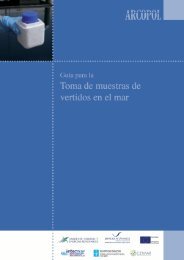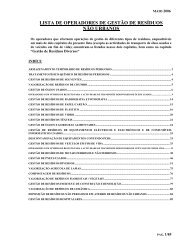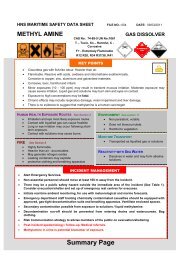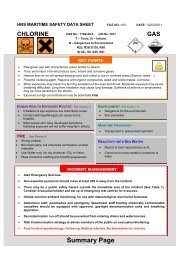ammonia gas (d) - Arcopol.eu
ammonia gas (d) - Arcopol.eu
ammonia gas (d) - Arcopol.eu
Create successful ePaper yourself
Turn your PDF publications into a flip-book with our unique Google optimized e-Paper software.
HNS MARITIME SAFETY DATA SHEET FILE NO.: 003 DATE: 09/03/2011AMMONIASECTION 3: HUMAN HEALTH HAZARDSCAS No: 7664-41-7 UN No: 1005F- Flammable, T – Toxic, C - Corrosive,N – Dangerous to EnvironmentR10, R23, R34, R50S(1/2), S9, S16, S26, S36/37/39, S45, S61GAS (D)Following exposure to any chemical, the adverse health effects you may encounter depend on several factors,including the amount to which you are exposed (dose), the way you are exposed, the duration of exposure, theform of the chemical and if you were exposed to any other chemicals.ROUTES OF ENTRY: Exposure by any route may be dangerous. Inhalation and ocular exposure are mostlikely due to its <strong>gas</strong>eous nature.POTENTIAL HEALTH EFFECTSINHALATIONEYESSKININGESTIONInhalation may result in irritation of eyes and nose with sore throat, cough, chest tightness,headache, ataxia and confusion. Dyspnoea and stridor due to laryngeal oedema my follow.Ocular exposure contact may result in pain, blepharospasm, lacrimation, conjunctivitis,palpebral oedema, photophobia and corneal burns which should be considered anophthalmic emergency.Dermal exposure may result in deep, full thickness, liquefaction burns due to thesolubilisation of proteins and collagen, saponification of lipids and the dehydration of tissuecells leading to extensive damage.Ingestion may cause immediate burning of the mouth and throat, drooling, difficultyswallowing with retrosternal and abdominal pain. There is often hypersalivation andvomiting. Haematemesis and shock may complicate severe cases. The larynx may also beburned causing oedema, airway obstruction and difficulty clearing bronchial secretions.Strong alkalis such as <strong>ammonia</strong> may damage the oesophagus more than the stomach withulceration, perforation and mediastinitis.There is no evidence to suggest that <strong>ammonia</strong> can affect the health of the unborn child.ACUTE HEALTH HAZARDS: Ammonia <strong>gas</strong> and mists of solution are severe respiratory tract irritants.Concentrated solutions or vapours may cause severe, penetrating dermal burns or necrosis. Ammonia maycause eye irritation, lacrimation and conjunctivitis and has been reported to cause temporary or permanentblindness. Ingestion may cause epi<strong>gas</strong>tric pain, nausea and vomiting, swelling of the lips, mouth and larynx.ppm mg m -3 Signs and symptoms50 35 Slight irritation to eyes, nose and throat100 70 Rapid irritation to eye and respiratory tract700 488 Immediately irritating to eyes and throat1500 1045 Pulmonary oedema and coughing2500 1742 Life threateningCHRONIC HEALTH HAZARDS: Prolonged low concentrations of <strong>ammonia</strong> may lead to chronic bronchitis,pulmonary fibrosis and chemical pn<strong>eu</strong>monitis.CARCINOGENICITY: Non Carcinogen. No reported reproductive or teratogenic effects.PAGE 4 OF 11










